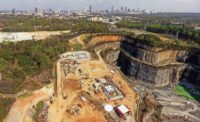The COVID-19 pandemic has caused a major disruption in what had been a thriving construction market. And like most of the industry, firms providing alternative project delivery services have been hit. But like all market downturns, the current crisis will end. Many firms delivering design-build and construction management-at-risk services believe pent-up demand will benefit them first.
The 2019 boom can be seen from the results in the ENR Top 100 Construction Management-at-Risk (CMAR) and the Top 100 Design-Build (DB) Firms lists. For the Top 100 CMAR list, the group generated $151.91 billion in revenue from CMAR projects in 2019, up 6.2% from $143.05 billion in 2018.
Interestingly, 2019 revenue numbers for domestic projects among the Top 100 CMAR rose $144.84 billion, a gain of 8.7% over the previous year. This more than makes up for the 27.4% drop in revenue from international CMAR projects, which fell to $7.08 billion in 2019 from $9.75 billion in 2018.
The revenue totals for surveyed design-build firms, however, are more problematic. This year, the Top 100 Design-Build Firms, as a group, generated $96.78 billion in revenue from design-build projects in 2019, a decline of 10.1% from $107.66 billion in 2018.
However, this decline is misleading. Fluor Corp., which was No. 2 on the Top 100 Design-Build Firms list last year with $10.96 billion in design-build revenue, did not participate in this year’s survey. It is undergoing an internal audit and has not released its financials to the public yet. Further, Jacobs, which was No. 3 on the list last year with $6.94 billion in design-build revenue, saw its design-build numbers plummet to $651.9 million. Jacobs last year sold its Energy, Chemicals and Resources division, which specializes in engineer-procure-construct projects in the energy market, to Australia’s Worley (which did not participate in this survey) for $3.3 billion, as Jacobs is focusing on government service-oriented lines.
If Fluor’s and Jacobs’ design-build revenue both were removed in comparing the ranking to the previous year, there would have been an overall 7.1% increase in design-build revenue.
|
Related Links |
COVID-19 Fallout
While the market for alternative project delivery had been growing strong, the industry now faces an uncertain future. The COVID-19 pandemic has caused huge disruptions in markets and processes, including those providing alternative project delivery.
The scope of the disruptions can be seen from the results of a survey released May 21 by the Design-Build Institute of America, Washington, D.C. DBIA sent out the survey to its members in May and received 316 responses.
The survey shows over 60% of respondents experienced owner-directed project delays or stoppages and 39% experienced supply-chain issues (see p. 42). Another major issue was a shortage of government personnel. Many firms have expressed frustration that permitting and site inspections have been delayed because government officials were not available.
“We found that our architect members are being hit hard as new projects are being put on hold. On the other hand, contractors are generally able to continue operations, even with local restrictions.”
– Lisa Washington, CEO, Design- Build Institute of America
Not every type of firm is experiencing the direct impact of the coronavirus crisis equally. “We found that our architect members are being hit hard as new projects are being put on hold. On the other hand, contractors are able to continue operations, even with local restrictions,” says Lisa Washington, DBIA’s CEO.
However, Washington points out that design-build is playing a role in dealing with the crisis. Many state and local governments have been assembling teams of designers and contractors to erect emergency medical facilities to cope with the influx of COVID-19 victims. “These arrangements may not be using textbook design-build contracts, but they are using classic design-build principals and techniques to deliver projects quickly and efficiently,” she says.
Many firms believe that alternative delivery firms will be the key to market recovery. “With disrupted global supply chains, travel restrictions and an influx of new norms at project sites, working with an integrated design-build/EPC firm … can provide a successful outcome on projects, even in today’s environment,” says Matt Ralston, senior vice president at Burns & McDonnell.
Many large firms agree an integrated approach will be needed to deal with the current crisis. “For the urgent COVID-19-related projects, we’re seeing a return to awarding projects using increasingly integrated delivery types based on trusted relationships who bring confidence in their ability to quickly execute a project,” says Vince Dipofi, CEO of SSOE, a Toledo, Ohio-based engineering firm that has begun to venture into contracting. He believes this is a trend that must continue when the market returns to a “new normal” in order for the industry to see the productivity gains necessary to deliver value to clients.
Public Agencies Feel the Strain
The pandemic has put a particular strain on state and local governments. The national unemployment rate has skyrocketed to 14.7% in April, from 4.4% in March and 3.5% in February. Further, businesses have been forced to close due to state and local quarantine orders. This has put a strain on state and local revenue receipts. Also, governments have been required to move resources away from construction to other priorities needed to fight the pandemic.
All these factors may accelerate the use of alternative project delivery in public infrastructure work. Many firms working in the infrastructure markets had already noted the increase of these delivery methods. “Integrated project delivery of capital projects using progressive design-build or CMAR continues to increase in numbers,” says Lou Carella, executive vice president of Walnut Creek, Calif.-based Carollo Engineers, one of the nation’s largest engineering firms in the water sector. He says the biggest drivers for integrated project delivery of capital projects continue to be a single point of responsibility, lowering risk and earlier cost certainty of construction costs.
“With disrupted global supply chains, travel restrictions and an infl ux of new norms at project sites, working with an integrated design-build/ EPC firm … can provide a successful outcome on projects, even in today’s environment.”
– Matt Ralston, senior vice president, Burns & McDonnell
Another engineering firm in the infrastructure sector observing the increased use of alternative project delivery is Watertown, Mass.-based VHB. “We are seeing more and more of our clients turn to alternative delivery, particularly design-build, to deliver both large and small projects,” says Steve McElligott, the firm’s transportation market leader. “DOTs are predominantly looking towards alternative delivery to accelerate projects and transfer risk to the contracting community.”
The shift is causing some engineering firms to act as consultants on project delivery. DOTs “that would typically enter into a traditional delivery mode of
design-bid-build are shifting to alternative delivery mechanisms, such as design-build, public-private partnerships (P3s) and construction manager/general contractor,” says Lou Cornell, CEO of WSP USA. The shift by DOTs to alternative project delivery is mainly driven by funding and schedule constraints, the need to manage risk and to “bundle projects together for more effective execution and delivery,” he adds.
Cornell says that the number of choices has many DOTs looking for help in how to administer their projects. “Clients are now coming to us looking for solutions rather than purely design or construction services as they are facing greater challenges with their ultimate clients or recipients, and the work is therefore being packaged differently,” he says.
Some firms worry that many owners, particularly in the public sector, are unfamiliar with the design-build process and expect it to be no different from past systems. “We are concerned that clients are utilizing procurement methods like design-build where they may not truly appreciate the cost to the contractor or designer and issue repeated changes throughout the procurement,” says Kumar Buvanendaran, CEO of engineering firm PRIME AE Group Inc., Baltimore.
However, DBIA’s Washington says that owners need to understand how they want their projects handled and what best meets their needs. She notes that DBIA has developed a database of over 300 successful design-build projects that is available to the public on the DBIA website. The database can be sorted by market sector, procurement method, contract format, how the design-build teams is structured and by region. “This gives owners a chance to review how design-build works and the steps required for a successful project,” she says.
P3 Concerns
There is a growing sense that, in the troubled economic times ahead, private financing of public projects through public-private partnerships may be necessary to aid cash-strapped public agencies.
While many in the industry believe P3s may aid in getting projects off the ground, their adoption has been slow. “While there has been a lot of chatter in the water industry of P3 opportunities and interest, there are not a lot of examples of successful delivery of P3 projects,” says Carella of Carollo Engineers.
The shift by DOTs to alternative project delivery “is mainly driven by the need to manage risk, funding constraints and time, and bundle projects together for more effective execution and delivery.”
– Lou Cornell, CEO, WSP USA
One of the problems is the level of risk associated with P3 projects. “We are seeing a change in appetite for P3 delivery due to the risks P3 consortiums are being asked to absorb, which are sometimes unknown,” says Mark Dvorak, president of Chicago-based engineer-architect EXP. He says some clients are moving away from P3 delivery and returning to more traditional delivery and design/build as a reaction to unanticipated project delays and cost escalation.
For example, Denver International Airport last year terminated its $1.8-billion P3 agreement with Great Hall Partners, a consortium led by Ferrovial Airports with partners Saunders/JLC Infrastructure (ENR, Aug. 19/26, 2019, pg. 12). The relationship, centering on the $650-million terminal renovation, ended up in squabbles over change orders, micromanagement and cost escalation. The decision sent shock waves through the industry over the use of P3s.
“Design-build is generally inherent in delivering a P3 project. But design-build is not the same as P3,” says Washington. She warns firms that using design-build on a P3 is a different contractual structure. However, she says the heart of most P3s is a cost-certain, schedule-certain design-build contract for the initial design and construction of the asset.





